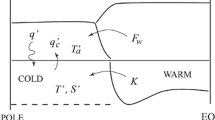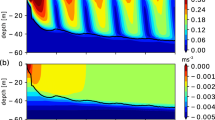Abstract
Munk (Deep Sea Res Oceanogr Abstr 13(4):707–730, 1966) showed that the mid-depth (1–3 km) vertical temperature profile is consistent with a one-dimensional vertical advection–diffusion balance, with a constant upwelling and an interior diapycnal diffusivity of \({\mathcal {O}}(10^{-4})\,\hbox {m}^{2}\,\hbox {s}^{-1}\). However, typical observed diffusivities in the interior are \({\mathcal {O}}(10^{-5})\,\hbox {m}^{2}\,\hbox {s}^{-1}\). Recent work suggested that the mid-depth stratification is set by Southern Ocean (SO) isopycnal slopes, governed by SO wind and eddies, that communicate the surface outcrop positions to the mid-depth ocean. It is shown here, using an idealized ocean general circulation model, that while SO dynamics play an important role by linking the surface water mass transformation by air-sea fluxes with the mid-depth interior stratification, they do not set the observed exponential stratification and that interior mixing must contribute. Strong diapycnal mixing concentrated near the ocean boundaries is shown to be balanced locally by upwelling. A one-dimensional Munk-like balance in these boundary-mixing areas, although with much larger mixing and upwelling, leads to an exponential mid-depth temperature stratification, which spreads via isopycnal advection and mixing to the ocean interior. The exponential profile is robust to vertical variations in the vertical velocity and persists despite the observed weak interior diapycnal mixing. These results may suggest a way to reconcile the observed exponential interior mid-depth temperature stratification, the weak diapycnal diffusivity observed in tracer release experiments, and the role of Southern Ocean dynamics.







Similar content being viewed by others
References
F. Bryan, Parameter sensitivity of primitive equation ocean general circulation models. J. Phys. Oceanogr. 17, 970–985 (1987)
K. Bryan, Accelerating the convergence to equilibrium of ocean-climate models. J. Phys. Oceanogr. 14, 666–673 (1984)
R. Ferrari, A. Mashayek, T.J. McDougall, M. Nikurashin, J.-M. Campin, Turning ocean mixing upside down. J. Phys. Oceanogr. 46(7), 2239–2261 (2016)
P.R. Gent, J. Willebrand, T.J. Mcdougall, J.C. Mcwilliams, Parameterizing eddy-induced tracer transports in ocean circulation models. J. Phys. Oceanogr. 25(4), 463–474 (1995)
C.C. Henning, G.K. Vallis, The effects of mesoscale eddies on the stratification and transport of an ocean with a circumpolar channel. J. Phys. Oceanogr. 35(5), 880–896 (2005)
T. Ito, J. Marshall, Control of lower-limb overturning circulation in the Southern Ocean by diapycnal mixing and mesoscale eddy transfer. J. Phys. Oceanogr. 38(12), 2832–2845 (2008)
H.L. Johnson, P. Cessi, D.P. Marshall, F. Schloesser, M.A. Spall, Recent contributions of theory to our understanding of the Atlantic meridional overturning circulation. J. Geophys. Res. Oceans 124(8), 5376–5399 (2019)
W.G. Large, J.C. Mcwilliams, S.C. Doney, Oceanic vertical mixing: a review and a model with a nonlocal boundary-layer parameterization. Rev. Geophys. 32(4), 363–403 (1994)
J.R. Ledwell, A.J. Watson, C.S. Law, Mixing of a tracer in the pycnocline. J. Geophys. Res. 103(C10), 21499–21529 (1998)
R. Lumpkin, K. Speer, Global ocean meridional overturning. J. Phys. Oceanogr. 37, 2550–2562 (2007)
J.R. Luyten, J. Pedlosky, H. Stommel, The ventilated thermocline. J. Phys. Oceanogr. 13(2), 292–309 (1983)
J. Marotzke, Boundary mixing and the dynamics of three-dimensional thermohaline circulations. J. Phys. Oceanogr. 27(8), 1713–1728 (1997)
J. Marshall, A. Adcroft, C. Hill, L. Perelman, C. Heisey, A finite-volume, incompressible Navier–Stokes model for studies of the ocean on parallel computers. J. Geophys. Res. 102, 5753–5766 (1997)
J. Marshall, T. Radko, Residual-mean solutions for the Antarctic Circumpolar Current and its associated overturning circulation. J. Phys. Oceanogr. 33(11), 2341–2354 (2003)
J. Marshall, T. Radko, A model of the upper branch of the meridional overturning of the Southern Ocean. Progr. Oceanogr. 70(2), 331–345 (2006)
A. Mashayek, R. Ferrari, M. Nikurashin, W.R. Peltier, Influence of enhanced abyssal diapycnal mixing on stratification and overturning circulation. J. Phys. Oceanogr. 45, 2580–2597 (2015)
A. Melet, R. Hallberg, S. Legg, K. Polzin, Sensitivity of the ocean state to the vertical distribution of internal-tide driven mixing. J. Phys. Oceanogr. 43, 602–615 (2013)
W. Munk, C. Wunsch, Abyssal recipes II: energetics of tidal and wind mixing. Deep-Sea Res. Part I-Oceanogr. Res. Pap. 45(12), 1977–2010 (1998)
W.H. Munk, Abyssal recipes. Deep Sea Res. Oceanogr. Abstr. 13(4), 707–730 (1966)
J.D. Nash, S.M. Kelly, E.L. Shroyer, J.N. Moum, T.F. Duda, The unpredictable nature of internal tides on continental shelves. J. Phys. Oceanogr. 42, 1981–2000 (2012)
M. Nikurashin, G. Vallis, A theory of deep stratification and overturning circulation in the ocean. J. Phys. Oceanogr. 41(3), 485–502 (2011)
M. Nikurashin, G. Vallis, A theory of the interhemispheric meridional overturning circulation and associated stratification. J. Phys. Oceanogr. 42, 1652–1667 (2012)
K.L. Polzin, J.M. Toole, J. Ledwell, R.W. Schmitt, Spatial variability of turbulent mixing in the abyssal ocean. Science 276(5309), 93–96 (1997)
M.H. Redi, Oceanic isopycnal mixing by coordinate rotation. J. Phys. Oceanogr. 12, 1154–1158 (1982)
P.B. Rhines, W.R. Young, A theory of the wind-driven circulation. I. Mid-ocean gyres. J. Mar. Res. 40(3), 559–596 (1982)
R. Samelson, Large-scale circulation with locally enhanced vertical mixing. J. Phys. Oceanogr. 28(4), 712–726 (1998)
J.R. Scott, J. Marotzke, The location of diapycnal mixing and the meridional overturning circulation. J. Phys. Oceanogr. 32(12), 3578–3595 (2002)
C.J. Shakespeare, A. McC, Hogg, An analytical model of the response of the meridional overturning circulation to changes in wind and buoyancy forcing. J. Phys. Oceanogr. 42(8), 1270–1287 (2012)
K.L. Sheen, J.A. Brearley, A.C. Naveira Garabato, D.A. Smeed, S. Waterman, J.R. Ledwell, M.P. Meredith, L. St. Laurent, A.M. Thurnherr, J.M. Toole et al., Rates and mechanisms of turbulent dissipation and mixing in the Southern Ocean: results from the diapycnal and isopycnal mixing experiment in the Southern Ocean (DIMES). J. Geophys. Res. Oceans 118(6), 2774–2792 (2013)
K. Speer, E. Tziperman, Rates of water mass formation in the North-Atlantic Ocean. J. Phys. Oceanogr. 22(1), 93–104 (1992)
L. St. Laurent, A.C. Naveira Garabato, J.R. Ledwell, A.M. Thurnherr, J.M. Toole, A.J. Watson, Turbulence and diapycnal mixing in Drake Passage. J. Phys. Oceanogr. 42(12), 2143–2152 (2012)
L.C. St. Laurent, A.M. Thurnherr, Intense mixing of lower thermocline water on the crest of the Mid-Atlantic Ridge. Nature 448(7154), 680–683 (2007)
AM. Thurnherr, L. St. Laurent, Turbulence and diapycnal mixing over the East Pacific Rise crest near \(10^{\circ } \text{N}\). Geophys. Res. Lett. 38, L15613 (2011)
E. Tziperman, On the role of interior mixing and air-sea fluxes in determining the stratification and circulation of the oceans. J. Phys. Oceanogr. 16, 680–693 (1986)
G.K. Vallis, Large-scale circulation and production of stratification: effects of wind, geometry, and diffusion. J. Phys. Oceanogr. 30(5), 933–954 (2000)
G. Walin, On the relation between sea-surface heat flow and the thermal circulation in the ocean. Tellus 34, 187–195 (1982)
A.F. Waterhouse et al., Global patterns of diapycnal mixing from measurements of the turbulent dissipation rate. J. Phys. Oceanogr. 44, 1854–1872 (2014)
C.L. Wolfe, P. Cessi, What sets the strength of the middepth stratification and overturning circulation in eddying ocean models? J. Phys. Oceanogr. 40, 1520–1538 (2010)
C.L. Wolfe, P. Cessi, The adiabatic pole-to-pole overturning circulation. J. Phys. Oceanogr. 41(9), 1795–1810 (2011)
Acknowledgements
MDM and ET were supported by NASA ROSES Grant NNX14AH39G and NSF Physical Oceanography Grant OCE-1535800. XY was supported by a summer undergraduate research fellowship from Peking University. Computational resources were provided by the NASA High-End Computing (HEC) Program through the NASA Advanced Supercomputing Center at NASA Ames and the NASA Center for Climate Simulation (NCCS) at Goddard Space Flight Center and on the Odyssey cluster supported by the FAS Division of Science, Research Computing Group at Harvard University. ET thanks the Weizmann Institute for its hospitality during parts of this work. All data and programs used for this study are available from the corresponding author.
Author information
Authors and Affiliations
Corresponding author
Rights and permissions
About this article
Cite this article
Miller, M.D., Yang, X. & Tziperman, E. Reconciling the observed mid-depth exponential ocean stratification with weak interior mixing and Southern Ocean dynamics via boundary-intensified mixing. Eur. Phys. J. Plus 135, 375 (2020). https://doi.org/10.1140/epjp/s13360-020-00375-y
Received:
Accepted:
Published:
DOI: https://doi.org/10.1140/epjp/s13360-020-00375-y




